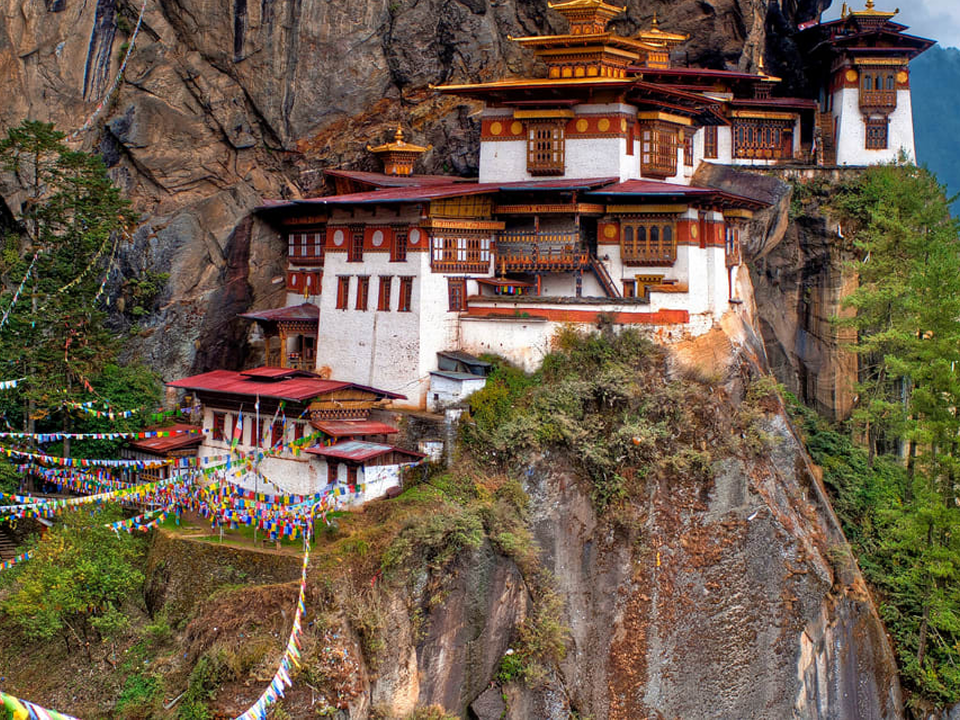Taktshang the Tigers Lair
~ Paro Dzong~ Drukgyal Dzong
~ National Museum
~ The Paro Thongdrel
~ Kyichu Lhakhang
~ Dungtse Lhakhang
Taktshang or the Tiger’s Nest Monastery is truly one of the most incredible sites and the most venerated places of pilgrimage in the Himalayan Buddhist world. The monastery clings to the side of a precipitous rock face at 2,950 meters above the sea level. For the average hiker it takes about 2 hours walk to reach the monastery from the nearest road-head. Getting there does involve a bit of an effort, but it truly is worth every bead of sweat.
Legend has it that sometime in 747 AD, Guru Padmasambhava flew to the cave astride a tigress in his wrathful manifestation of Guru Dorji Drolo in order to subdue evil spirits in the locality and preserve the integrity of the Buddhist teachings, which is why the cave came to be known as Taktshang or the Tiger’s lair. It is also maintained that it was his consort, Tashi Khyden (daughter of Sendha Gyelp whose health Guru helped restore in return for which Tashi Khyden was offered as his consort) who transformed into the tigress and flew to the spot from Sengye Dzong in Kurtoe. There at the cave, the Guru is said to have meditated for three years, three months, three weeks, three days and three hours. A temple complex was first built at that spot in 1692. Today, Paro Taktsang is the best known of the thirteen ‘Taktsangor’ or caves in which the Guru meditated. The cliff on which Taktshang stands is also supposed to resemble a ritual dagger known as Phurpa.

Many Buddhist masters also spent time here in meditation, the foremost being Langchen Pelgi Sengye, one of the twenty five disciples of Guru Rinpoche. The site was later visited and blessed by many other prominent Buddhist saints and masters as well, including the likes of Milarepa, Thangthong Gyalpo, Phajo Dugom Zhigpo and Zhabdrung Ngawang Namgyal.
Guru Rimpoche or Padmasambhava was a great saint and mystic from the Swat valley in modern day Pakistan who visited Bhutan and Tibet in the 8th century, tamed the hostile and negative forces and reintroduced Buddhism in these regions, broadly referred to as the second propagation of the faith. He is worshipped popularly in Bhutan and the Himalayan regions as the Second Buddha and regarded with the utmost reverence. The most important festivals celebrated in Bhutan – the Tshechus, are held to commemorate his birth and celebrate his magnificent deeds.
Guru Rimpoche or Padmasambhava was a great saint and mystic from the Swat valley in modern day Pakistan who visited Bhutan and Tibet in the 8th century, tamed the hostile and negative forces and reintroduced Buddhism in these regions, broadly referred to as the second propagation of the faith. He is worshipped popularly in Bhutan and the Himalayan regions as the Second Buddha and regarded with the utmost reverence. The most important festivals celebrated in Bhutan – the Tshechus, are held to commemorate his birth and celebrate his magnificent deeds.
